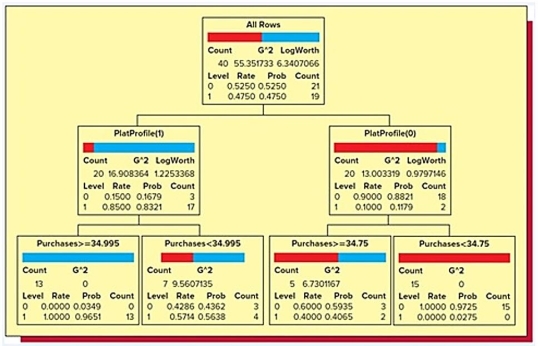Multiple Choice
Suppose that a bank wishes to predict whether or not an existing holder of its Silver credit card will upgrade, for an annual fee, to its Platinum credit card. To do this, the bank carries out a pilot study that randomly selects 40 of its existing Silver card holders and offers each Silver card holder an upgrade to its Platinum card. Here, the response variable Upgrade equals 1 if the Silver card holder decided to upgrade and 0 otherwise. Moreover, the predictor variable Purchases is last year's purchases (in thousands of dollars) by the Silver card holder, and the predictor variable PlatProfile equals 1 if the Silver card holder conforms to the bank's Platinum profile and 0 otherwise. Below is the classification tree they derived from the data collected in the study.  Assume they classify those with an upgrade probability estimate of at least .5 as upgraders. Based on this classification tree, a member of the study sample who made $28,520 in purchases last year and conformed to the bank's Platinum profile but did not upgrade to the Platinum card would be…
Assume they classify those with an upgrade probability estimate of at least .5 as upgraders. Based on this classification tree, a member of the study sample who made $28,520 in purchases last year and conformed to the bank's Platinum profile but did not upgrade to the Platinum card would be…
A) accurately classified as an upgrader.
B) accurately classified as a non-upgrader.
C) inaccurately classified as an upgrader.
D) inaccurately classified as a non-upgrader.
Correct Answer:

Verified
Correct Answer:
Verified
Q53: The confusion matrix is not a good
Q54: Because different classification techniques will perform better
Q55: An MBA admissions officer wishes to predict
Q56: A cable television company has randomly selected
Q57: An automobile finance company analyzed a sample
Q59: An automobile finance company analyzed a sample
Q60: Which of the following possible response variables
Q61: An automobile finance company analyzed a sample
Q62: An automobile finance company analyzed a sample
Q63: An internet service provider (ISP) has randomly